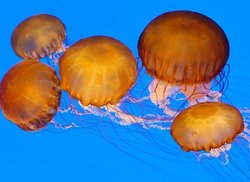Other Animals
Animals are a major group of organisms, classified as the kingdom Animalia or Metazoa. In general they are multicellular, capable of locomotion and responsive to their environment, and feed by consuming other organisms. more...
Their body plan becomes fixed as they develop, usually early on in their development as embryos, although some undergo a process of metamorphosis later on.
The name animal comes from the Latin word animal, of which animalia is the plural, and ultimately from anima, meaning vital breath or soul.
Characteristics
Aristotle divided the living world between animals and plants, and this was followed by Carolus Linnaeus in the first hierarchical classification. Since then biologists have begun emphasizing evolutionary relationships, and so these groups have been restricted somewhat. For instance, microscopic protozoa were originally considered animals because they move, but are now treated separately.
Kingdom Animalia has several characteristics that set it apart from other living things. Animals are eukaryotic and multicellular, which separates them from bacteria and most protists. They are heterotrophic, generally digesting food in an internal chamber, which separates them from plants and algae. They are also distinguished from plants, algae, and fungi by lacking cell walls.
Structure
With a few exceptions, most notably the sponges (Phylum Porifera), animals have bodies differentiated into separate tissues. These include muscles, which are able to contract and control locomotion, and a nervous system, which sends and processes signals. There is also typically an internal digestive chamber, with one or two openings. Animals with this sort of organization are called metazoans, or eumetazoans when the former is used for animals in general.
All animals have eukaryotic cells, surrounded by a characteristic extracellular matrix composed of collagen and elastic glycoproteins. This may be calcified to form structures like shells, bones, and spicules. During development it forms a relatively flexible framework upon which cells can move about and be reorganized, making complex structures possible. In contrast, other multicellular organisms like plants and fungi have cells held in place by cell walls, and so develop by progressive growth. Also, unique to animal cells are the following intercellular junctions: tight junctions, gap junctions, and desmosomes.
Reproduction and development
Nearly all animals undergo some form of sexual reproduction. Adults are diploid or occasionally polyploid. They have a few specialized reproductive cells, which undergo meiosis to produce smaller motile spermatozoa or larger non-motile ova. These fuse to form zygotes, which develop into new individuals.
Many animals are also capable of asexual reproduction. This may take place through parthenogenesis, where fertile eggs are produced without mating, or in some cases through fragmentation.
Read more at Wikipedia.org



